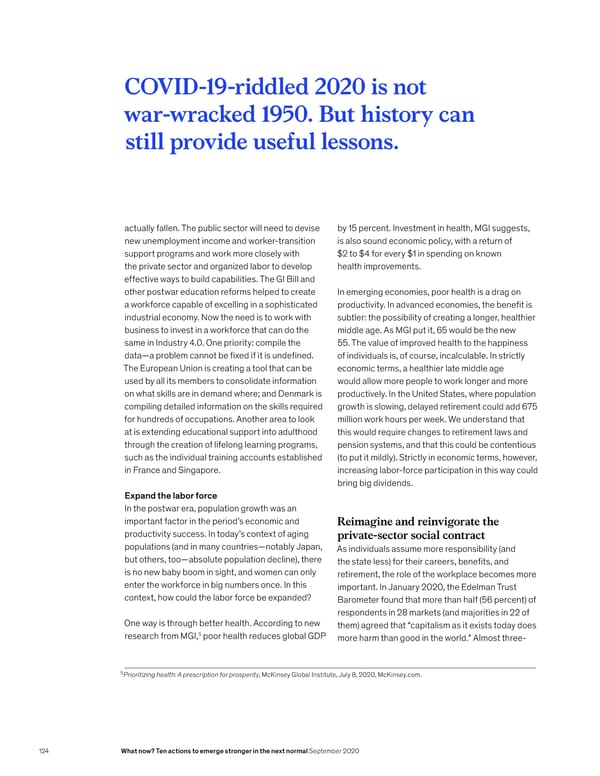COVID-19-riddled 2020 is not war-wracked 1950. But history can still provide useful lessons. actually fallen. The public sector will need to devise by 15 percent. Investment in health, MGI suggests, new unemployment income and worker-transition is also sound economic policy, with a return of support programs and work more closely with $2 to $4 for every $1 in spending on known the private sector and organized labor to develop health improvements. effective ways to build capabilities. The GI Bill and other postwar education reforms helped to create In emerging economies, poor health is a drag on a workforce capable of excelling in a sophisticated productivity. In advanced economies, the benefit is industrial economy. Now the need is to work with subtler: the possibility of creating a longer, healthier business to invest in a workforce that can do the middle age. As MGI put it, 65 would be the new same in Industry 4.0. One priority: compile the 55. The value of improved health to the happiness data—a problem cannot be fixed if it is undefined. of individuals is, of course, incalculable. In strictly The European Union is creating a tool that can be economic terms, a healthier late middle age used by all its members to consolidate information would allow more people to work longer and more on what skills are in demand where; and Denmark is productively. In the United States, where population compiling detailed information on the skills required growth is slowing, delayed retirement could add 675 for hundreds of occupations. Another area to look million work hours per week. We understand that at is extending educational support into adulthood this would require changes to retirement laws and through the creation of lifelong learning programs, pension systems, and that this could be contentious such as the individual training accounts established (to put it mildly). Strictly in economic terms, however, in France and Singapore. increasing labor-force participation in this way could bring big dividends. Expand the labor force In the postwar era, population growth was an important factor in the period’s economic and Reimagine and reinvigorate the productivity success. In today’s context of aging private-sector social contract populations (and in many countries—notably Japan, As individuals assume more responsibility (and but others, too—absolute population decline), there the state less) for their careers, benefits, and is no new baby boom in sight, and women can only retirement, the role of the workplace becomes more enter the workforce in big numbers once. In this important. In January 2020, the Edelman Trust context, how could the labor force be expanded? Barometer found that more than half (56 percent) of respondents in 28 markets (and majorities in 22 of One way is through better health. According to new them) agreed that “capitalism as it exists today does research from MGI,5 poor health reduces global GDP more harm than good in the world.” Almost three- 5 Prioritizing health: A prescription for prosperity, McKinsey Global Institute, July 8, 2020, McKinsey.com. 124 What now? Ten actions to emerge stronger in the next normal September 2020
 What Now? Page 125 Page 127
What Now? Page 125 Page 127